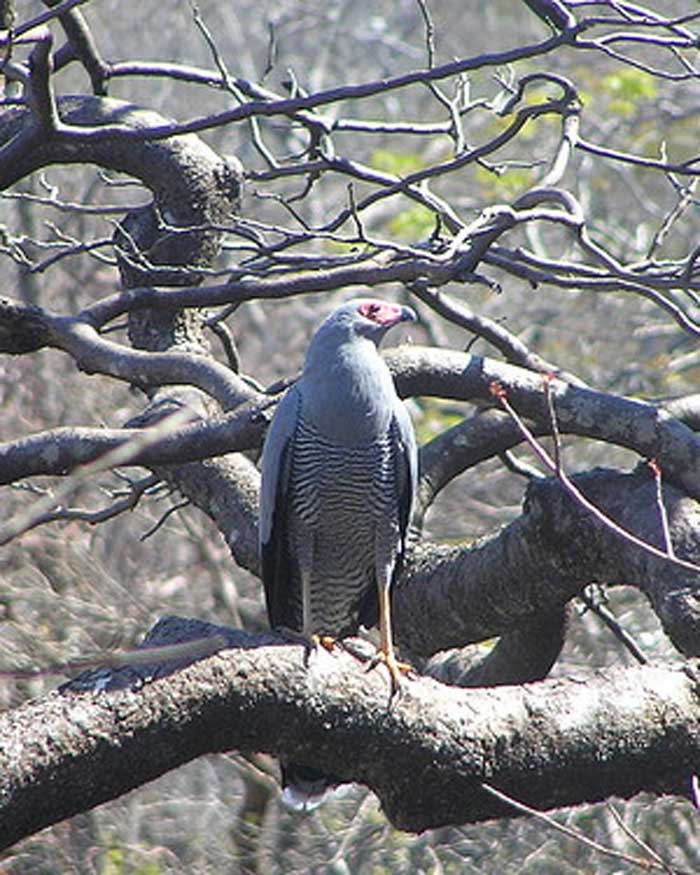
Polyboroides radiatus, (*)
Superregnum: Eukaryota
Cladus: Unikonta
Cladus: Opisthokonta
Cladus: Holozoa
Regnum: Animalia
Subregnum: Eumetazoa
Cladus: Bilateria
Cladus: Nephrozoa
Superphylum: Deuterostomia
Phylum: Chordata
Subphylum: Vertebrata
Infraphylum: Gnathostomata
Megaclassis: Osteichthyes
Cladus: Sarcopterygii
Cladus: Rhipidistia
Cladus: Tetrapodomorpha
Cladus: Eotetrapodiformes
Cladus: Elpistostegalia
Superclassis: Tetrapoda
Cladus: Reptiliomorpha
Cladus: Amniota
Classis: Reptilia
Cladus: Eureptilia
Cladus: Romeriida
Subclassis: Diapsida
Cladus: Sauria
Infraclassis: Archosauromorpha
Cladus: Crurotarsi
Divisio: Archosauria
Cladus: Avemetatarsalia
Cladus: Ornithodira
Subtaxon: Dinosauromorpha
Cladus: Dinosauriformes
Cladus: Dracohors
Cladus: Dinosauria
Ordo: Saurischia
Cladus: Eusaurischia
Subordo: Theropoda
Cladus: Neotheropoda
Cladus: Averostra
Cladus: Tetanurae
Cladus: Avetheropoda
Cladus: Coelurosauria
Cladus: Tyrannoraptora
Cladus: Maniraptoromorpha
Cladus: Maniraptoriformes
Cladus: Maniraptora
Cladus: Pennaraptora
Cladus: Paraves
Cladus: Eumaniraptora
Cladus: Avialae
Infraclassis: Aves
Cladus: Euavialae
Cladus: Avebrevicauda
Cladus: Pygostylia
Cladus: Ornithothoraces
Cladus: Ornithuromorpha
Cladus: Carinatae
Parvclassis: Neornithes
Cohors: Neognathae
Cladus: Neoaves
Ordo: Accipitriformes
Familia: Accipitridae
Subfamilia: Polyboroidinae
Genus: Polyboroides
Species: Polyboroides radiatus
Name
Polyboroides radiatus (Scopoli, 1786)
References
Deliciae florae faunae insubricae 2 p.85
Vernacular names
čeština: Jestřábec madagaskarský
English: Madagascar Harrier-Hawk
español: Aguilucho malgache
日本語: マダガスカルチュウヒダカ
The Madagascar harrier-hawk (Polyboroides radiatus) is a very large species of bird of prey in the family Accipitridae, endemic to Madagascar.
Description
The Madagascar harrier-hawk is a largish raptor with long and broad wings which when folded almost reach to the tip of the tail. It has a black tail with a single broad grey band bisecting the black half way along its length, Adult birds are grey above with blackish flight feathers. The underparts are white with dense dark barring on the breast, belly and underwing coverts while the upper breast and throat are the same colour as the upperparts and form a grey hood, broken by the yellow face. The bill is yellow with a black tip and the legs are yellow.[2]
Distribution
The Madagascar harrier-hawk is quite widespread and common, albeit in small numbers, in most regions of Madagascar but it is scarce on the deforested central plateau. It can be found from sea level to 2,000 m (6,600 ft) altitude.[3]
Habitat
The Madagascar harrier-hawk occurs in a variety of habitats but seems to favour undisturbed lowland rainforest.[4] It has also been recorded from montane rainforest, spiny desert scrub, degraded forests and other wooded habitats, including plantations of exotic trees.[3]
Habits
The nest of the Madagascar harrier-hawk is a large, bulky structure which is constructed using sticks and situated approximately 18–30 m (59–98 ft) above the ground within the canopy of a tree.[4] Nesting has been observed the months of September, October, and November.[3] The eggs are brooded by both sexes and hatch asynchronously, with the older sibling often killing its younger brood mates. Fledging takes about seven weeks.[4] On at least one occasion a nest was found within a colony of Sakalava weavers.[3]
The Madagascar harrier-hawk has a varied diet and has been recorded eating small birds, rodents, reptiles, insects, small lemurs. Like the African harrier-hawk they possess the unusual morphological adaptation of having an intertarsal joint that allows their legs to flex backwards and forwards. This means that they can use their feet to probe and remove prey from hidden sites such as holes in tree trunks, weaver nests and rock crevices where they can extract nestling birds from such normally inaccessible places.[3][4]
Taxonomic notes
The Madagascar harrier-hawk forms a superspecies with the African harrier-hawk and has been regarded by some authorities as a subspecies of that species. However, if that is the case then the combined species would be called P. radiatus as this name has priority.[3]
References
BirdLife International (2016). "Polyboroides radiatus". IUCN Red List of Threatened Species. 2016: e.T22695415A93508513. doi:10.2305/IUCN.UK.2016-3.RLTS.T22695415A93508513.en. Retrieved 13 November 2021.
Kemp, Alan; Kemp, Meg (1998). SASOL Birds of Prey of Africa and its Islands. New Holland. pp. 130–131. ISBN 1-85974-100-2.
"Madagascar Harrier-hawk Polyboroides radiatus". The Peregrine Fund. Retrieved 25 October 2016.
"Madagascar Harrier-Hawk (Polyboroides radiatus)". Planet of Birds. Archived from the original on 26 October 2016. Retrieved 25 October 2016.
Retrieved from "http://en.wikipedia.org/"
All text is available under the terms of the GNU Free Documentation License

